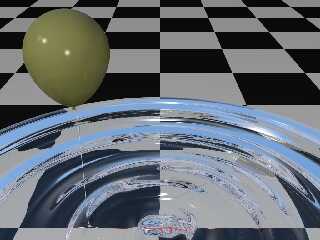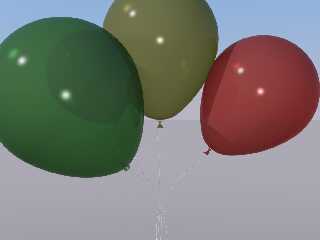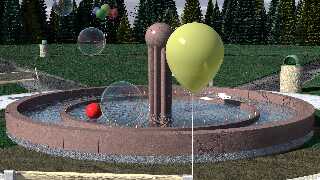 |
 |
|
 |
|
 |
|  |
|  |
|
 |
|
 |
|  |
|  |
|
 |
"RATH, CHRISTOPHER A" <car### [at] comcast net> wrote:
> The trees are isosurfaces using a cone function with noise added in to
> get the layers of branches. I can add some noise to the slope function
> that drives the main shape and perturb the central access as well. I
> was surprised, though, by how nice they look with so little effort.
Those are _isosurfaces_??!
That's amazing.
I'm glad you share your WIPs as things develop.
You have a lot of interesting approaches, and your scene turn out really well!
- BE net> wrote:
> The trees are isosurfaces using a cone function with noise added in to
> get the layers of branches. I can add some noise to the slope function
> that drives the main shape and perturb the central access as well. I
> was surprised, though, by how nice they look with so little effort.
Those are _isosurfaces_??!
That's amazing.
I'm glad you share your WIPs as things develop.
You have a lot of interesting approaches, and your scene turn out really well!
- BE
Post a reply to this message
|
 |
|  |
|  |
|
 |
|
 |
|  |
|  |
|
 |
On 4/18/2024 1:35 PM, Alain Martel wrote:
> Le 2024-04-18 à 08:56, RATH, CHRISTOPHER A a écrit :
>> On 4/17/2024 12:17 PM, Cousin Ricky wrote:
>>> On 2024-04-17 08:28 (-4), RATH, CHRISTOPHER A wrote:
>>>>>
>>>> This is a ways from being done, but I wanted to share the updated image
>>>> with the bubbles fixed. The balloon texture is still not quite right,
>>>> even when I render with radiosity (which this version does not).
>>>
>>> I doubt radiosity makes any difference here. I would give Alain's
>>> suggestion of blurred reflection a try. If you haven't seen it yet, the
>>> technique is at:
>>>
>>> https://wiki.povray.org/content/Knowledgebase:Language_Questions_and_Tips#Topic_13
>>>
>>> To avoid having this technique stall and take forever, use Alain's
>>> modification:
>>>
>>> https://news.povray.org/49b9809b%241%40news.povray.org
>>>
>>> And I would cut the reflection in half or even lower; and if you're
>>> using finish-level Fresnel, remember to use the reduced reflection as
>>> its argument:
>>>
>>> finish
>>> { fresnel 0.5
>>> reflection { 0.5 fresnel }
>>> conserve_energy
>>> ...
>>> }
>>>
>>> The reflection of the water highlights on the right edge of the balloon
>>> looks suspiciously metallic. Is this not a rubber balloon?
>>>
>> I looked at the code for doing the blurred reflections and started
>> experimenting with it. I was able to get a nice blurring mirror using
>> CSG objects and this technique where I can play with the variables.
>>
>> However, the balloon is an isosurface with a pretty small accuracy
>> value to remove artifacts, so hitting it with 40X more rays drops the
>> rendering to a halt. I can get it to go with a small blur count, but
>> I don't think that will give me the blur effect.
>>
>> I'm still playing with it. If I can find a good way to create the
>> balloon using CSG instead of isosurfaces that may be the better
>> solution, since I don't need a bumpy surface.
>>
>> -- Chris R
> Then, you need to use the micro-normal technique. Add a normal statement
> scaled very small.
>
> normal{granite scale 0.01}
>
> Then use a reasonable amount of antialiasing. Without antialiasing, the
> micro-normal will result in a grainy image.
>
> Optionally : You may add some averaged blurring using a small number of
> textures. Using averaged textures and micro-normals, you can use about 4
> to 6 averaged textures and get very good results.
I noticed, (duh), that my complex shape function for the balloons, (A 2D
polar function I found that I then turn into an SOR in the isosurface),
looks remarkably like the built-in ovus shape with a slightly stretched
distance value. So, I recreated the balloons using that and was able to
get a reasonable rendering time with a small scale blur and 10 blur
samples that looks pretty good "in the lab", which included a wavy
reflective pool to mimic the reflections in the fountain. It isn't as
fast as a simple box or sphere, but better than the isosurface.
However, now that I've inserted it into the scene my rendering is
getting stuck on the balloon again, even with pretty bad anti-aliasing,
so I will go back to the drawing board with your suggestion above using
the micro-normals. I think dropping the fresnel and reflection values
to 0.3 or lower is at least removing the unexpected shininess, but maybe
the micro-normals will give enough of the blurring to make it realistic
enough.
--
-- Chris R
Post a reply to this message
|
 |
|  |
|  |
|
 |
|
 |
|  |
|  |
|
 |
On 4/18/2024 8:08 PM, Bald Eagle wrote:
> "RATH, CHRISTOPHER A" <car### [at] comcast net> wrote:
>
>> The trees are isosurfaces using a cone function with noise added in to
>> get the layers of branches. I can add some noise to the slope function
>> that drives the main shape and perturb the central access as well. I
>> was surprised, though, by how nice they look with so little effort.
>
> Those are _isosurfaces_??!
> That's amazing.
>
> I'm glad you share your WIPs as things develop.
> You have a lot of interesting approaches, and your scene turn out really well!
>
> - BE
>
>
>
Isosurfaces are my go-to for most of the elements in my scenes, unless
they are too far away for surface texture to be noticeable. In close-up
views, I never find that just using normals gives me the look that I
want, whereas I have complete control with an isosurface.
I pay for this, though, as my scenes tend to render pretty slowly...
--
-- Chris R net> wrote:
>
>> The trees are isosurfaces using a cone function with noise added in to
>> get the layers of branches. I can add some noise to the slope function
>> that drives the main shape and perturb the central access as well. I
>> was surprised, though, by how nice they look with so little effort.
>
> Those are _isosurfaces_??!
> That's amazing.
>
> I'm glad you share your WIPs as things develop.
> You have a lot of interesting approaches, and your scene turn out really well!
>
> - BE
>
>
>
Isosurfaces are my go-to for most of the elements in my scenes, unless
they are too far away for surface texture to be noticeable. In close-up
views, I never find that just using normals gives me the look that I
want, whereas I have complete control with an isosurface.
I pay for this, though, as my scenes tend to render pretty slowly...
--
-- Chris R
Post a reply to this message
|
 |
|  |
|  |
|
 |
|
 |
|  |
|  |
|
 |
On 4/18/2024 1:35 PM, Alain Martel wrote:
> Le 2024-04-18 à 08:56, RATH, CHRISTOPHER A a écrit :
>> On 4/17/2024 12:17 PM, Cousin Ricky wrote:
>>> On 2024-04-17 08:28 (-4), RATH, CHRISTOPHER A wrote:
>>>>>
>>>> This is a ways from being done, but I wanted to share the updated image
>>>> with the bubbles fixed. The balloon texture is still not quite right,
>>>> even when I render with radiosity (which this version does not).
>>>
>>> I doubt radiosity makes any difference here. I would give Alain's
>>> suggestion of blurred reflection a try. If you haven't seen it yet, the
>>> technique is at:
>>>
>>> https://wiki.povray.org/content/Knowledgebase:Language_Questions_and_Tips#Topic_13
>>>
>>> To avoid having this technique stall and take forever, use Alain's
>>> modification:
>>>
>>> https://news.povray.org/49b9809b%241%40news.povray.org
>>>
>>> And I would cut the reflection in half or even lower; and if you're
>>> using finish-level Fresnel, remember to use the reduced reflection as
>>> its argument:
>>>
>>> finish
>>> { fresnel 0.5
>>> reflection { 0.5 fresnel }
>>> conserve_energy
>>> ...
>>> }
>>>
>>> The reflection of the water highlights on the right edge of the balloon
>>> looks suspiciously metallic. Is this not a rubber balloon?
>>>
>> I looked at the code for doing the blurred reflections and started
>> experimenting with it. I was able to get a nice blurring mirror using
>> CSG objects and this technique where I can play with the variables.
>>
>> However, the balloon is an isosurface with a pretty small accuracy
>> value to remove artifacts, so hitting it with 40X more rays drops the
>> rendering to a halt. I can get it to go with a small blur count, but
>> I don't think that will give me the blur effect.
>>
>> I'm still playing with it. If I can find a good way to create the
>> balloon using CSG instead of isosurfaces that may be the better
>> solution, since I don't need a bumpy surface.
>>
>> -- Chris R
> Then, you need to use the micro-normal technique. Add a normal statement
> scaled very small.
>
> normal{granite scale 0.01}
>
> Then use a reasonable amount of antialiasing. Without antialiasing, the
> micro-normal will result in a grainy image.
>
> Optionally : You may add some averaged blurring using a small number of
> textures. Using averaged textures and micro-normals, you can use about 4
> to 6 averaged textures and get very good results.
Here's what I've come up with so far. I abandoned the texture-averaging
blurring technique because it's just too slow, even using the ovus. I'm
using a micro-normal instead. I also added a small transmit value along
with the filter to the pigments. The colors have also been muted to
better reflect what happens when you inflate a balloon. The reflection
has been toned down quite a bit.
These are test renderings of the distant balloon cluster and the nearby
balloon. Getting them to look like this in the full scene is still a
bit of a challenge.
--
-- Chris R
Post a reply to this message
Attachments:
Download 'balloon-bench.png' (613 KB)
Download 'balloon-cluster.png' (305 KB)
Preview of image 'balloon-bench.png'

Preview of image 'balloon-cluster.png'

|
 |
|  |
|  |
|
 |
|
 |
|  |
|  |
|
 |
"RATH, CHRISTOPHER A" <car### [at] comcast net> wrote:
> On 4/18/2024 1:35 PM, Alain Martel wrote:
> >> On 4/17/2024 12:17 PM, Cousin Ricky wrote:
> >>> On 2024-04-17 08:28 (-4), RATH, CHRISTOPHER A wrote:
> >>>>>
> >>>> This is a ways from being done, but I wanted to share the updated image
> >>>> even when I render with radiosity (which this version does not).
> >>>
> >>> technique is at:
> >>>
> >>>
https://wiki.povray.org/content/Knowledgebase:Language_Questions_and_Tips#Topic_13
> >>>
> >>> To avoid having this technique stall and take forever, use Alain's
> >>> modification:
> >>>
> >>> https://news.povray.org/49b9809b%241%40news.povray.org
> >>>
> >>> And I would cut the reflection in half or even lower; and if you're
> >>> using finish-level Fresnel, remember to use the reduced reflection as
> >>> its argument:
> >>>
> >>> finish
> >>> { fresnel 0.5
> >>> }
> >>>
> >>> The reflection of the water highlights on the right edge of the balloon
> >>>
> >> I looked at the code for doing the blurred reflections and started
> >> CSG objects and this technique where I can play with the variables.
> >>
> >> However, the balloon is an isosurface with a pretty small accuracy
> >> value to remove artifacts, so hitting it with 40X more rays drops the
> >> I don't think that will give me the blur effect.
> >>
> >> balloon using CSG instead of isosurfaces that may be the better
> >> solution, since I don't need a bumpy surface.
> >>
> >> -- Chris R
> > Then, you need to use the micro-normal technique. Add a normal statement
> > scaled very small.
> >
> > normal{granite scale 0.01}
> >
> > Then use a reasonable amount of antialiasing. Without antialiasing, the
> > micro-normal will result in a grainy image.
> >
> > Optionally : You may add some averaged blurring using a small number of
> > textures. Using averaged textures and micro-normals, you can use about 4
> > to 6 averaged textures and get very good results.
> Here's what I've come up with so far. I abandoned the texture-averaging
> blurring technique because it's just too slow, even using the ovus. I'm
> using a micro-normal instead. I also added a small transmit value along
> with the filter to the pigments. The colors have also been muted to
> better reflect what happens when you inflate a balloon. The reflection
> has been toned down quite a bit.
>
> These are test renderings of the distant balloon cluster and the nearby
> balloon. Getting them to look like this in the full scene is still a
> bit of a challenge.
>
> --
> -- Chris R
Finished a radiosity rendering with updated materials for the balloons. I think
it's better than the original.
-- Chris R net> wrote:
> On 4/18/2024 1:35 PM, Alain Martel wrote:
> >> On 4/17/2024 12:17 PM, Cousin Ricky wrote:
> >>> On 2024-04-17 08:28 (-4), RATH, CHRISTOPHER A wrote:
> >>>>>
> >>>> This is a ways from being done, but I wanted to share the updated image
> >>>> even when I render with radiosity (which this version does not).
> >>>
> >>> technique is at:
> >>>
> >>>
https://wiki.povray.org/content/Knowledgebase:Language_Questions_and_Tips#Topic_13
> >>>
> >>> To avoid having this technique stall and take forever, use Alain's
> >>> modification:
> >>>
> >>> https://news.povray.org/49b9809b%241%40news.povray.org
> >>>
> >>> And I would cut the reflection in half or even lower; and if you're
> >>> using finish-level Fresnel, remember to use the reduced reflection as
> >>> its argument:
> >>>
> >>> finish
> >>> { fresnel 0.5
> >>> }
> >>>
> >>> The reflection of the water highlights on the right edge of the balloon
> >>>
> >> I looked at the code for doing the blurred reflections and started
> >> CSG objects and this technique where I can play with the variables.
> >>
> >> However, the balloon is an isosurface with a pretty small accuracy
> >> value to remove artifacts, so hitting it with 40X more rays drops the
> >> I don't think that will give me the blur effect.
> >>
> >> balloon using CSG instead of isosurfaces that may be the better
> >> solution, since I don't need a bumpy surface.
> >>
> >> -- Chris R
> > Then, you need to use the micro-normal technique. Add a normal statement
> > scaled very small.
> >
> > normal{granite scale 0.01}
> >
> > Then use a reasonable amount of antialiasing. Without antialiasing, the
> > micro-normal will result in a grainy image.
> >
> > Optionally : You may add some averaged blurring using a small number of
> > textures. Using averaged textures and micro-normals, you can use about 4
> > to 6 averaged textures and get very good results.
> Here's what I've come up with so far. I abandoned the texture-averaging
> blurring technique because it's just too slow, even using the ovus. I'm
> using a micro-normal instead. I also added a small transmit value along
> with the filter to the pigments. The colors have also been muted to
> better reflect what happens when you inflate a balloon. The reflection
> has been toned down quite a bit.
>
> These are test renderings of the distant balloon cluster and the nearby
> balloon. Getting them to look like this in the full scene is still a
> bit of a challenge.
>
> --
> -- Chris R
Finished a radiosity rendering with updated materials for the balloons. I think
it's better than the original.
-- Chris R
Post a reply to this message
Attachments:
Download 'scene-v1.1-hd-mq-rad-2024-05-29.png' (4204 KB)
Preview of image 'scene-v1.1-hd-mq-rad-2024-05-29.png'

|
 |
|  |
|  |
|
 |
|
 |
|  |
|
 |




![]()